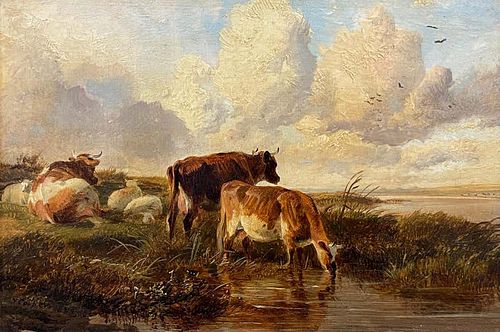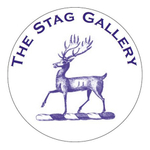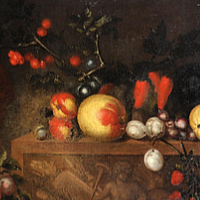Original Victorian Signed Oil Pastoral Landscape Cattle & Sheep Resting by Water
About Auction
May 11, 2022 - May 22, 2022
A finely curated auction of European fine art, presenting original paintings from the 17th century right through to the latter part of the 20th century: Old Masters, Portraits, Marines, Landscapes, Sporting Art.... Stag Gallery Auctions staggallerycollections@gmail.com
- Lot Description
Tranquil Pastures by Thomas Sidney Cooper (British, 1803-1902) signed and dated lower left corner, 1853 oil painting on board, framed framed: 12.5 x 16 inches condition: very good - completely ready to hang provenance: formerly with David Messum; private collection, England A very beautiful fully signed and dated original oil painting by one of the leading animal and landscape artists of the Victorian era, Thomas Sidney Cooper (British, 1803-1902). The work has excellent provenance having been with David Messum, one of the most respected dealers in England. Thomas Sidney (Sidney) Cooper was born in St Peter’s Street Canterbury on 26 September 1803 to William and Sarah Cooper. He was christened Thomas Cooper and at some point adopted Sydney or Sidney as his middle name. At the age of 12 he started working as a coach painter and later a scene painter, continuing to draw and paint in his spare time. When he was 21 he was helped by his uncle to move to London and study at the Royal Academy. However, he didn’t complete the course and returned to Canterbury. Shortly afterwards in 1824, he travelled to Brussels where he met Eugène Joseph Verboeckhoven who had a great influence on his work. He also met and married Charlotte Pearson the daughter of a mathematician. After the revolution broke out they returned to London in 1831 where Cooper started selling paintings of the cattle that he sketched at Smithfield Market. The couple lived at Portland Terrace, St John’s Wood and together had four children. His son Thomas George Cooper also became an artist. In 1833 he made his debut at the Royal Academy, where he continued to exhibit regularly until his death. He also exhibited at the Royal Society of British Artists and the British Institution between 1833 and 1863. He was elected ARA in 1845 and RA in 1867. From the early 1840’s he lived at 16 Wellington Terrace, until the 1850’s when he moved to 2 Dorset Square, Regent’s Park. He continued to live there for over 10 years until he moved to 42 Chepstow Villas, Bayswater. Around 1849, he had a second house built in Harbledown, Canterbury and named it Vernon Holme after his patron and from where he would also paint and exhibit. Cooper specialised in paintings of cattle or sheep, which earned him the nickname of 'Cow Cooper'. He became one of the most accomplished and successful animal landscape painters of the 19th century. He built Alms Houses in Canterbury and in 1882 set up the Canterbury Sidney Cooper School of Art. In July 1901, he was awarded the Commander of the Royal Victorian Order (CVO). Cooper died at Harbledown, Canterbury on 7 February 1902 and was buried at St Martin Churchyard. Examples of his work can be found at the Royal Museum in Canterbury, Tate Gallery, Victoria and Albert Museum, Atkinson Art Gallery, Birmingham Museum, Brighton and Hove Museum, Northampton Museum Sheffield Museum and other public collections.
Dimension
Height: 12.50Width: 16.00 - Shipping Info
-
We have our own in house professional packing and shipping department - and can ship any painting worldwide for very reasonable rates. Please feel free to ask any questions you may have regarding the process. We mainly use Fedex and all parcels come with full online tracking. A signature is required for the parcel on delivery. Transit insurance to cover loss or theft is available, please ask for a quote. Due to the fragile nature of old frames, our shippers do not provide compensation for any damage caused during transit. By placing your bids, you accept and acknowledge that we cannot compensate or refund, under any circumstances, for any damage occurring to frames during transit. Transit time from the UK to American is around 2-3 working days. Thank you.
-
- Payment & Auction Policies
-
Available payment options
-
- Buyer's Premium



 EUR
EUR CAD
CAD AUD
AUD GBP
GBP MXN
MXN HKD
HKD CNY
CNY MYR
MYR SEK
SEK SGD
SGD CHF
CHF THB
THB















